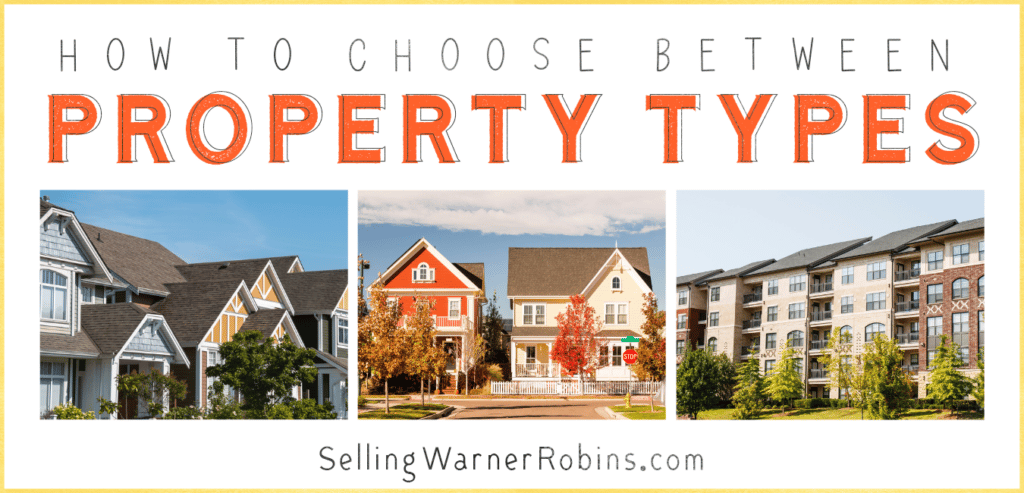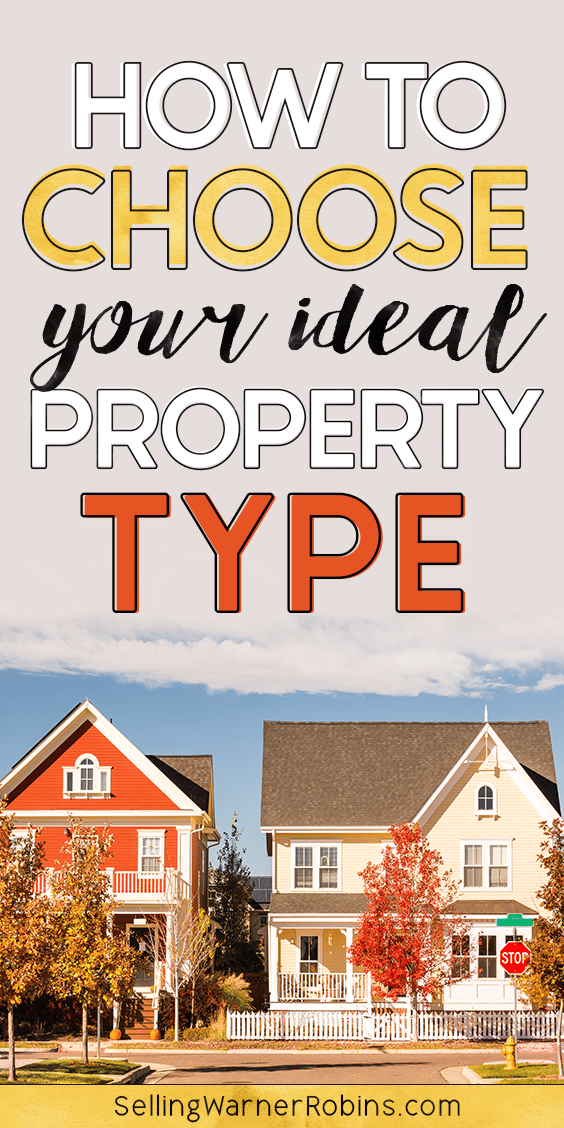How to Choose Between Property Types: Townhouse vs. Condo vs. Single-Family Home

Buyers have three primary options when purchasing residential properties: condominiums, townhouses, and single-family dwellings. Condos often appeal to those who don’t want to spend much time on maintenance. Single-family homes and townhouses offer greater flexibility and privacy. Buyers should also consider several other factors, like available interior space, rules about pets, shared amenities, monthly expenses, parking space(s), home prices, and noise levels. Here’s how to choose between property types and also learn some key information about buying condos, townhouses, and single-family homes.
Condominium
Most condo units exist in urban areas or recreational destinations, such as ski resorts and golf courses. They provide many of the same convenient benefits as rental apartments while allowing residents to own their homes.
Condominium occupants only fully own the interiors of their units, extending to things like plumbing fixtures, appliances, and kitchen cabinets. Individual residents don’t own any exterior surfaces, such as their condos’ roofing or siding. They share ownership of common areas with other association members.
The lack of land ownership keeps condominium prices relatively low. Condos cost substantially less than single-family properties in nearly all large cities, helping them become popular with first-time buyers.
Condominium owners must pay property taxes, association fees, and utility bills. Some associations include certain utilities in their prices, such as the public water supply. It usually costs less to insure a condo unit compared to other homes.
Condo owners only need to maintain interior surfaces and equipment. For example, they’re responsible for fixing broken faucets, doorknobs, and refrigerators. The association handles major condo maintenance projects, such as repaving the parking lot. While residents have to pay for these repairs in their monthly fees, the cost becomes more affordable when divided among many individuals.
Condo associations also enforce rules. These policies protect buildings from damage and reduce interior noise. At the same time, they can prevent residents from having pets or earning money through home occupations. Understanding a condo community’s rules is crucial before buying a unit.
Owners typically need an association’s approval to replace the flooring, electrical wiring, ceiling tiles, or plumbing. They might also have to request permits from the local government. While condos don’t provide as much flexibility as single-family homes, they allow more interior customization than rented apartments.
Like an apartment, a condominium usually shares multiple walls with neighbors. Occupants might live above and below it as well. Residents may need to use shared hallways and stairs to reach their units. These traits mean that condos offer less privacy than other homes.
On the upside, many condominium buildings feature elevators, and the units frequently have few or no stairs, making it easier for residents to come and go. Only a one-story house could provide equal or superior accessibility.
Generally, each condo owner has one parking space in a shared lot. Therefore, a condominium might not be the best option for someone who owns multiple vehicles. Although condos supply comparatively little parking, residents benefit from lot maintenance and snow plowing provided by the association.
With a few exceptions, condos usually offer less interior space than other homes. While they don’t accommodate as many people or belongings, this is beneficial in some ways. It’s easier for an owner to clean, maintain, and furnish a compact space.
A significant advantage of condo living is the ability to use convenient common areas, such as laundry rooms, hiking paths, community gardens, and swimming pools. Residents benefit from these amenities without worrying about tasks like measuring pool chemicals or repairing broken washing machines.
Furthermore, owners usually receive various services in exchange for paying association fees. Common examples include garbage removal and lawn maintenance. Certain communities also supply amenities like internet access, flood insurance, or heat.
When purchasing condo units, most people pay comparatively low home inspection fees. However, the mortgage rates tend to be a bit higher, and banks often request more documents from condo buyers. The association may also charge move-in, credit check, or transfer fees.
Townhouse
A townhouse is essentially a vertical “slice” of a long building with multiple stories, bringing together several advantages of single-family and condo living. Townhouses are frequently in cities and suburbs. Although these properties don’t include much land, owners may have separate driveways and lawns.
Most townhouse residents own both the interior and exterior portions of their dwellings. The land beneath the building belongs to them as well. They might also own small amounts of land behind or in front of their homes.
A townhouse is usually less expensive than a comparable single-family dwelling. Because townhouses are typically larger and include land, they cost more than most condos. However, some of the monthly and yearly expenses are more affordable.
Most townhouse residents pay association fees, but they’re often lower than those of a condo unit. Other expenses include property taxes, heat, and utility bills. Owners tend to pay more for insurance than they’d spend in a condominium but slightly less than they would in a single-family home.
In addition to maintaining the interiors of their homes, townhouse occupants may need to fix damaged roofs, outer walls, and HVAC systems. However, some associations perform exterior repairs and include the expense in their fees. Townhouse maintenance generally costs somewhat more than condo upkeep.
Like condominium buildings, townhouse communities may have rules regarding parking, clotheslines, large dogs, or noise. While these rules might work to your advantage in some cases, some association rules can be unnecessarily rigid.
A townhouse offers somewhat more flexibility than a condo. While owners usually can’t build additions or outbuildings, they have more freedom to choose exterior colors, windows, doors, water heater models, and HVAC systems. Nevertheless, association rules may prohibit specific colors or siding materials.
Townhouses provide a moderate level of privacy and some protection from interior noise. They share one or two outer walls with neighbors, but no one lives above or below them. Likewise, each dwelling has an exterior entrance.
An entrance on the first floor makes it easier to move into a townhouse. It can also simplify package, appliance, and furniture deliveries. However, these dwellings usually have at least two stories, so they’re not ideal for someone who wants to avoid using stairs.

Townhouses supply somewhat better parking than the average condo or apartment. Each residence might have a driveway or garage. On the other hand, some communities offer shared parking lots. Owners with dedicated driveways may be responsible for maintaining them.
On average, a townhouse’s square footage is greater than a condominium’s but smaller than a single-family home’s. This may provide an appealing compromise for homebuyers who desire substantial space without the hassles of maintaining an entire building on a large plot of land.
Many townhouse associations offer access to common recreational areas, such as tennis courts and clubhouses. Some also maintain fitness centers with various exercise equipment. Residents can enjoy these amenities without traveling elsewhere, buying gym memberships, or purchasing expensive machines.
A townhouse tends to include fewer services than a condo unit. Owners are more likely responsible for things like mowing grass and paying individual utility bills. Nonetheless, some associations handle trash removal, paving, or snow plowing.
The process of purchasing a townhouse is similar to that of a single-family home. Buyers obtain the same types of mortgages and insurance policies. These properties are larger than condo units and include more equipment, so they cost more to inspect.
Single-Family Home
It’s possible to find single-family dwellings in cities, small towns, rural areas, and suburbs, but they remain less common in densely populated urban neighborhoods. Compared to other options, these stand-alone buildings provide greater versatility and customization, allowing buyers to find the right decoration style for their property.
Almost everything on a single-family property belongs to the owner: the interior, exterior, fixtures, equipment, foundation, outbuildings, and land. Utility companies may own certain lines or fuel tanks. Some deeds give neighbors the right to cross specific parts of a property. Be sure to examine the deed and disclosure for details carefully.
Greater ownership and more interior space increase the total value of a real estate property, so single-family dwellings generally cost more than other homes in equivalent condition. However, buyers can usually find opportunities to purchase inexpensive houses that need a lot of work.
The owner of a single-family home must pay for utilities, heat, snow removal, insurance, and property taxes. While owners face additional bills, they have somewhat more control over their home’s finances. For example, it’s possible to cut costs by installing a more efficient furnace or using a gravel driveway.
Single-family homeowners must maintain just about everything, including HVAC equipment, roofing, siding, plumbing, wiring, pavement, and landscaping. Many homes use public water and sewer systems, but owners are still responsible for the underground pipes on their land. Insurance or a home warranty might pay for some repairs under the right circumstances.
Unless they live in gated communities, residents usually don’t need to follow as many rules in single-family dwellings. They’re less likely to face restrictions regarding pets or what they can park in the driveway. Local law may even allow a homeowner to start a small business in the garage, but this isn’t always possible.
Residents also have more freedom to personalize their homes. For example, they can choose the type of siding, roofing, or windows. They normally don’t need to comply with any rules about exterior paint. With the proper permits, owners may construct additions, sheds, and garages.
No neighbors live in the same building, so a single-family home usually delivers the highest level of privacy. Outdoor noise and eavesdropping can still be problematic on small lots; it’s best to look for a home with adequate insulation and double-pane windows.
A single-family house offers the convenience of a dedicated entrance on the first story. Multiple exterior doors may make the moving process easier. For optimal accessibility, look for a one-level house constructed on a slab (no basement).
Most single-family properties have private driveways with one or more parking spaces. In some cases, other homeowners share part of the driveway. Numerous homes also feature carports or garages. Owners who don’t need their garage space can earn substantial money by renting it out.
On average, single-family dwellings surpass the sizes of other homes. Many range from 800 to 3,000 square feet and demand more upkeep but offer spacious living quarters and storage rooms. This extra space can help residents avoid spending money on self-storage rentals.
A single-family house usually doesn’t provide access to common areas unless it’s part of a homeowners’ association. A few homes include deeded access to waterfront land. Although you’ll probably have to travel longer distances, local public parks and recreation centers may offer some of the same amenities as a condo community.
Likewise, single-family homeowners must independently complete tasks like tree trimming, chimney cleaning, and pressure washing. In urban areas, the local government may supply services like garbage disposal and recycling at no extra charge. Some cities also remove snow from sidewalks.
It’s wise to schedule a thorough home inspection before buying a house, with the service costing an average of $341. Single-family homes usually include land, so banks often require land surveys to be completed before approving mortgage applications.
Choosing Between Condos, Townhouses, & Single-Family Homes
The right decision depends on a homebuyer’s preferences, location, budget, skills, and plans for the future. Condominiums offer greater simplicity, while single-family homes provide more control over your expenses and surroundings. Townhouses represent an appealing solution for people who have difficulty choosing between these two options.
At the end of the day, pick the option that meets your needs and provides flexibility for any future plans. Happy hunting as you find the best solution to your housing needs. ~ Anita ~
About Anita Clark Realtor
Anita Clark has written 687 posts on this blog.
by Anita Clark Anita is a residential Real Estate Agent in Warner Robins Georgia, with Coldwell Banker Access Realty (478) 953-8595, aiding buyers and sellers with all their real estate questions on her Warner Robins blog.



